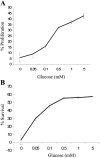Glucose metabolism in lymphocytes is a regulated process with significant effects on immune cell function and survival
- PMID: 18577716
- PMCID: PMC2638731
- DOI: 10.1189/jlb.0108024
Glucose metabolism in lymphocytes is a regulated process with significant effects on immune cell function and survival
Abstract
Lymphocytes require glucose uptake and metabolism for normal survival and function. The signals that regulate the expression and localization of glucose transporter 1 (Glut1) to allow glucose uptake in T cells are now beginning to be understood. Resting T cells require extracellular signals, such as cytokines, hormones, and growth factors, or low-level TCR stimulation to take up adequate glucose to maintain housekeeping functions. In the absence of extrinsic signals, resting T cells internalize and degrade Glut1 and cannot maintain viability. Activated T cells have dramatically increased metabolic requirements to support the energy and biosynthetic needs necessary for growth, proliferation, and effector function. In particular, glucose metabolism and aerobic glycolysis fuel this demand. Therefore, activation of T cells causes a large increase in Glut1 expression and surface localization. If glucose uptake is limited, glycolytic flux decreases to a level that no longer sustains viability, and proapoptotic Bcl-2 family members become activated, promoting cell death. However, excessive glucose uptake can promote hyperactive immune responses and possible immune pathology. Tight regulation of glucose uptake is required to maintain immune homeostasis, and understanding of these metabolic pathways may lead to therapeutic strategies to target some forms of cancer or autoimmunity.
Figures





Similar articles
-
Glucose uptake is limiting in T cell activation and requires CD28-mediated Akt-dependent and independent pathways.J Immunol. 2008 Apr 1;180(7):4476-86. doi: 10.4049/jimmunol.180.7.4476. J Immunol. 2008. PMID: 18354169 Free PMC article.
-
IL-7 promotes Glut1 trafficking and glucose uptake via STAT5-mediated activation of Akt to support T-cell survival.Blood. 2008 Feb 15;111(4):2101-11. doi: 10.1182/blood-2007-06-096297. Epub 2007 Nov 27. Blood. 2008. PMID: 18042802 Free PMC article.
-
Metabolic reprogramming is required for antibody production that is suppressed in anergic but exaggerated in chronically BAFF-exposed B cells.J Immunol. 2014 Apr 15;192(8):3626-36. doi: 10.4049/jimmunol.1302062. Epub 2014 Mar 10. J Immunol. 2014. PMID: 24616478 Free PMC article.
-
[Glucose transporters in lymphocytes: expression and effects on lymphocyte functions].Sheng Wu Gong Cheng Xue Bao. 2024 Jul 25;40(7):1997-2009. doi: 10.13345/j.cjb.230893. Sheng Wu Gong Cheng Xue Bao. 2024. PMID: 39044571 Review. Chinese.
-
Glucose transporter 1 in rheumatoid arthritis and autoimmunity.Wiley Interdiscip Rev Syst Biol Med. 2020 Jul;12(4):e1483. doi: 10.1002/wsbm.1483. Epub 2020 Feb 21. Wiley Interdiscip Rev Syst Biol Med. 2020. PMID: 32084302 Review.
Cited by
-
Monocytes perturbation implicated in the association of stress hyperglycemia with postoperative poor prognosis in non-diabetic patients with Stanford type-A acute aortic dissection.Cardiovasc Diabetol. 2024 Oct 26;23(1):379. doi: 10.1186/s12933-024-02468-9. Cardiovasc Diabetol. 2024. PMID: 39462406 Free PMC article.
-
Glucose-dependent glycosphingolipid biosynthesis fuels CD8+ T cell function and tumor control.bioRxiv [Preprint]. 2024 Oct 14:2024.10.10.617261. doi: 10.1101/2024.10.10.617261. bioRxiv. 2024. PMID: 39464161 Free PMC article. Preprint.
-
PDK1 regulation of mTOR and hypoxia-inducible factor 1 integrate metabolism and migration of CD8+ T cells.J Exp Med. 2012 Dec 17;209(13):2441-53. doi: 10.1084/jem.20112607. Epub 2012 Nov 26. J Exp Med. 2012. PMID: 23183047 Free PMC article.
-
Natural Products Induce Different Anti-Tumor Immune Responses in Murine Models of 4T1 Mammary Carcinoma and B16-F10 Melanoma.Int J Mol Sci. 2023 Nov 24;24(23):16698. doi: 10.3390/ijms242316698. Int J Mol Sci. 2023. PMID: 38069022 Free PMC article.
-
Sterol regulatory element-binding proteins are essential for the metabolic programming of effector T cells and adaptive immunity.Nat Immunol. 2013 May;14(5):489-99. doi: 10.1038/ni.2570. Epub 2013 Apr 7. Nat Immunol. 2013. PMID: 23563690 Free PMC article.
References
-
- Morgan T E, Wong A M, Finch C E. Anti-inflammatory mechanisms of dietary restriction in slowing aging processes. Interdiscip Top Gerontol. 2007;35:83–97. - PubMed
-
- Franceschi C. Inflammaging as a major characteristic of old people: can it be prevented or cured? Nutr Rev. 2007;65:S173–S176. - PubMed
-
- Vasto S, Candore G, Balistreri C R, Caruso M, Colonna-Romano G, Grimaldi M P, Listi F, Nuzzo D, Lio D, Caruso C. Inflammatory networks in ageing, age-related diseases and longevity. Mech Ageing Dev. 2007;128:83–91. - PubMed
-
- Brod S A. Unregulated inflammation shortens human functional longevity. Inflamm Res. 2000;49:561–570. - PubMed
-
- Buckley R H. Molecular defects in human severe combined immunodeficiency and approaches to immune reconstitution. Annu Rev Immunol. 2004;22:625–655. - PubMed
Publication types
MeSH terms
Substances
Grants and funding
LinkOut - more resources
Full Text Sources
Other Literature Sources
Miscellaneous

